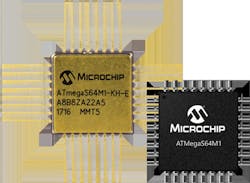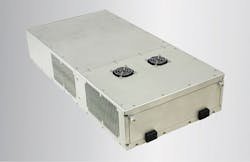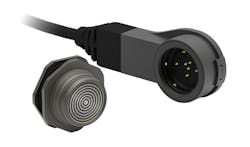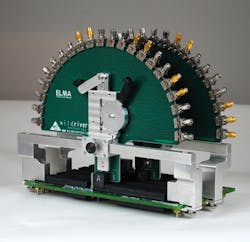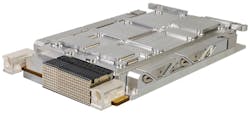2018 Military & Aerospace Technology Innovation Awards announced for aerospace and defense achievement
By Mil & Aero staff
NASHUA, N.H. — Military & Aerospace Electronics and Intelligent Aerospace today announced their 2018 Technology Innovation Awards to recognize companies offering substantial military, aerospace, and avionics design solutions.
Awards are in three tiers — ranging from platinum, the highest, to the gold awards, and finally to the silver awards — and are based on the recommendations of an independent panel of industry judges.
The ATmegaS64M1 AVR microcontroller (MCU) from Microchip Technology Inc. in Chandler, Ariz., brings the AVR core with CAN databus capabilities to the aerospace industry. It is designed for enhanced radiation, extended temperatures, and increased reliability in critical aerospace applications, and comes with CAN controller, power stage controller, A/D and D/A controller, and analog comparators.
The ATmegaS64M1 AVR microcontroller (MCU) from Microchip Technology Inc.
The ADRV9008/9 from Analog Devices in Norwood, Mass., is an integrated, radio frequency (RF) agile transceiver offering dual transmitters and receivers, integrated synthesizers, and digital signal processing. With a turning range from 75 MHz to 6 GHz, it offers wide bandwidth and high performance in single-chip TDD solution for communications, aerospace and defense, and electronic test & measurement applications.
The HSR40 high-speed network-attached storage (NAS) data recorder from the Curtiss-Wright Corp. Defense Solutions Division in Ashburn, Va., offers 40 Gigabit Ethernet handling the incoming data, with dual Xeon D processors and two built-in 40 Gigabit Ethernet interfaces. The processors can absorb the incoming data and redirect it to the persistent storage media, using third-generation PCI Express. Data pipelines over the backplane to the PCI Express-based non-volatile memory express (NVMe) solid-sate drives. Drives are installed onto removable memory blades, each with a maximum capacity of 32 terabytes, allowing for quick offloading of data for post mission analysis.
The HSR40 high-speed network-attached storage (NAS) data recorder from the Curtiss-Wright Corp. Defense Solutions Division in Ashburn, Va.
The LP360 rugged connector from Fischer Connectors in St-Prex, Switzerland, is for dismounted soldier systems, to enable foot soldiers to share information in real time. It connects and powers electronic devices body-worn by soldiers, and is an integral part of the Fischer intelligent vest, based on a shared data and power bus with wiring on the inside, one central battery for all, and connectors that work as a hub interface at strategically chosen locations.
The LP360 rugged connector from Fischer Connectors in St-Prex, Switzerland.
The ATS-6100 WFT wire fault test and measurement system from Astronics Test Systems Inc. in East Aurora, N.Y., is designed to detect existing and potential wire faults and help extend the life of aging military or civil aircraft, ships, ground vehicles, and other high-vibration equipment where operational failure would be catastrophic. It detects hard and soft faults in a handheld, self-contained tablet, and eliminates the need to terminate the opposite end of the cable for testing, limiting human interaction and leaving cables undisturbed in the system.
The S402-SW Tiger from General Micro Systems in Rancho Cucamonga, Calif., is a mobile battlefield data center that provides server-class performance in a ruggedized, conduction-cooled system. Developed for the U.S. Army’s Product Manager Mine Resistant Ambush Protected Vehicle Systems (PdM MRAP VS) the S402-LC/SW is sealed and operates in temperatures from -40 to 85 degrees Celsius with no fans required.
The VPX Backplane Probe Card Test Fixture from Elma Electronic in Fremont, Calif., enables characterization of differential VPX backplane channels between any two points on any 3U or 6U VPX backplane. It was designed for use on backplanes intended to support high speed signaling protocols such as PCI Express 2.1, InfiniBand DDR, Serial Rapid IO 2.2, PCI Express 3.0, Ethernet 10GBASE-KR, InfiniBand QDR, or InfiniBand FDR. The platform comprises three elements: a set of probe cards, a mechanical test fixture and a calibration card.
The VPX Backplane Probe Card Test Fixture from Elma Electronic in Fremont, Calif.
Simics from Wind River Systems in Alameda, Calif., is simulation software that provides the access, automation, and collaboration to enable agile and continuous development practices. By using virtual platforms and simulation, aerospace and defense software developers can decouple their work from physical hardware and its limitations during development. Software developers use Simics to simulate nearly anything from a single chip to complete systems and networks. Simics can run unmodified target software.
The TRRUST-Stor VPX Radiation-Tolerant Solid-State Drive from Mercury Systems in Andover, Mass., is a commercial solid-state drive (SSD) engineered for harsh operating environments using SpaceVPX standards. Although designed for commercial satellite applications, the device also can adapt to other applications where radiation exposure may occur, including high-altitude aircraft, airborne weapons, and mission-critical ground computing systems. TRRUST-Stor VPX RT SSD includes advanced BuiltSECURE error-correction algorithms paired with large geometry industrial-grade single-level cell (SLC) NAND flash memory.
The TRRUST-Stor VPX Radiation-Tolerant Solid-State Drive from Mercury Systems in Andover, Mass.
The S1U-MD Cyclone 1U rack-mount multi-domain rugged computer system from General Micro Systems (GMS) in Rancho Cucamonga, Calif., is two complete Intel Xeon-based rugged computer server subsystems, each with as many as 18 cores. The server subsystems are packaged together, but electrically isolated, including their separate power supplies and APUs. Cyclone is intended for military and aerospace Red/Black networks that also require storage-such as found on platforms with SIPR/NIPR networks.
The Axon Miniature Data Acquisition Unit from the Curtiss-Wright Corp. Defense Solutions Division in Ashburn, Va., is an ultra-compact and lightweight data acquisition system that works as a remote node or as a stand-alone chassis. Axon uses a 1-gigabit-per-second serial backplane to support high data rates. This design also enables designers to place off-the-shelf data acquisition modules in ultra-miniature “Axonite” housings and locate them remotely. It helps decrease the installation time and cost of the instrumentation while simultaneously reducing wiring weight.
SystemLink from National Instruments Corp. in Austin, Texas, is software that enables engineering teams to connect, manage, and optimize automated test and measurement systems. SystemLink improves operational efficiency and system uptime by providing a centralized web application for automating tasks such as systems deployment and management, test monitoring, and data analysis and reporting. SystemLink improves configuration compliance by discovering system settings and parameters and enabling remote configuration and diagnostics functions.
The Gallium Nitride (GaN) field effect transistor (FET) power supply solution from Renesas Electronics Corp. in Tokyo comprises the Intersil ISL70040SEH GaN FET driver and ISL70023SEH and ISL70024SEH GaN FETs to provide power to ferrite switch drivers, motor control driver circuits, heater control modules, embedded command modules, 100- and 28-volt power conditioning, and redundancy switching systems in satellites and launch vehicles.
The Gallium Nitride (GaN) field effect transistor (FET) power supply solution from Renesas Electronics Corp. in Tokyo.
The CTA803 AC-DC power supply from Aegis Power Systems Inc. in Murphy, N.C., is for low size, weight, and power (SWaP) applications for advanced military armored vehicles. It is housed in a water-tight enclosure and designed to meet MIL-STD-810F environmental standards, EMI requirements of MIL-STD-461F, and the 28-volt vehicle requirements of MIL-STD-1275E. It weighs 115 pounds and can accommodate U.S. Army counter-UAS technology needs.
The SR429/4D NEXSYS ARINC 429 Multi-bit Decoder from Applied Avionics Inc. in Fort Worth, Texas, can provide a binary decode of several data bits from one ARINC 429 data label. The SR429/4D is configurable with either 2x4 or 3x8 decode capabilities in less than 1 cubic inch of space. It offers configuration options for ARINC transmission speed, discrete output type, handling of SDI bits, and parity checking. Optionally, the SR429/4D can be configured with fail-sense circuitry that can simultaneously monitor the operation of the signal converter.
The RACE0161 AV/Unmanned Driving Solution from Crystal Group Inc. in Hiawatha, Iowa, is a high-performance, rugged embedded autonomous vehicle computer that harnesses modern commercial off-the-shelf (COTS) components stabilized in a rugged, compact enclosure constructed of aircraft-grade aluminum to streamline and speed the development and deployment of safe, robust, and reliable autonomous and unmanned vehicles and systems. A turnkey system, it helps overcome common challenges related to power and thermal management, size and weight, reliability, harsh elements and extreme environments, and an upgrade path to accommodate future needs and technologies.
The D2D-34S ATR chassis from Atrenne Computing Solutions in Brockton, Mass., supports the development-to-deployment program (D2D) life cycle, maximizing use of COTS components for development and demonstration with upgradeability for deployment, for reduced risk, reduced schedule, and reduced costs. This approach allows the product to use the same platform to support customers through their program life cycle.
The QPD1025L 1800-Watt (P3dB) discrete gallium nitride on silicon carbide high electron mobility transistor power IC from Qorvo in Greensboro, N.C., is for identification friend-or-foe (IFF) systems, avionics, and test instrumentation. It operates from 1.0 to 1.1 GHz., and input prematch within the package results in ease of external board match and saves board space. The device is in an industry standard air cavity package, and can support CW and pulsed operations.
The ZM3 enterprise-class small-form-factor mission computer from Zmicro Inc. in San Diego is for space-constrained applications such as manned and unmanned airborne intelligence, surveillance, and reconnaissance. It is equipped with an NVIDIA Quadro P6000 graphics processing unit (GPU) accelerator, and comes in a rugged design that’s about the size of a shoebox and weighs nine pounds. This lightweight computer packs in a 16-Core Intel Xeon D processor, three PCI Express expansion slots, as many as two removable storage drives and double-wide COTS high-end graphics cards. It provides the capabilities of a rackmount server in a fraction of the size and weight.
The OpenVPX CMOSS Convergence Development Platform from Elma Electronic Inc. in Fremont, Calif., is a complete test environment that supports OpenVPX embedded computing application development where compliance with the hardware convergence requirements of the military CMOSS (C4ISR/EW Modular Open Suite of Standards) initiative is the goal. At the heart of the system is Elma’s 12-slot CMOSS backplane, with 12 payloads and two power supply slots. The backplane features high-speed RF and optical I/O connectivity. The platform includes OpenVPX computer and networking modules, support for IEEE1588 precision timing, dual high-wattage pluggable VITA 62 compliant power supplies, and support for air- and conduction-cooled modules.
The BuiltSAFE GS Software Multi-Core Graphics Renderer from Mercury Systems in Andover, Mass., is for safety-critical applications, and enables advanced graphics on devices without a graphics processing unit (GPU), rendering purely in software, to eliminate the need for a GPU. This results in less hardware, less complexity, and lower certification costs for many applications. The high-performance safety-certifiable rendering engine is for applications ranging from avionics, to automotive displays. Data items required to achieve the highest levels of safety certification are available.
The VPX3-1260 3U VPX 8th Gen Intel Xeon E-2176M single-board computer from Curtiss-Wright Defense Solutions, offers a leap in performance over previous generations of Core i7 and Xeon processors in the smallest 3U form factor. Leveraging Intel’s first-ever six-core processor, the VPX3-1260 is designed to deliver more than 50 percent more processing power than previous for-core designs. The VPX3-1260 offers 10-Gigabit and 40-Gigabit Ethernet connectivity for fast data transfer and high network productivity. It has a local NVMe local solid-state drive, and is built to VITA 47 standards. It provides high non-throttling performance, and offers Intel’s latest Trusted Computing features, such as Intel Boot Guard and UEFI Secure Boot, and offers Intel Software Guard Extensions (SGX) for secured run-time software enclaves.
The Rugged Video Gateway Range product family from Curtiss-Wright Defense Solutions provides a flexible building block for complex video management and integration. It’s interoperable with the Curtiss-Wright RVG range enabling complex, scalable, solutions. For example, the format converter can combine in a video management system with the RVG-SD1 digital video switch and/or the RVG-SA1 analog video switch. Other elements are available for configuring a complete VMS — include rugged LCD touchscreen mission displays, and digital HD video recorders.
The BuiltSECURE System-in-Package (SiP) Secure Processor from Mercury Systems incorporates several types of devices — typically memory and a processor — in one package. Mercury’s BuiltSECURE SiP technology incorporates several discrete components, such as FPGA, processor, passive devices, volatile memory, and nonvolatile memory, in addition to more specialized components. It can replicate the capabilities of a custom ASIC for embedded security, and supports analog-to-digital converters and digital-to-analog converters for applications where RF inputs must be digitized and processed. It can be deployed for ground platforms, aircraft, unmanned vehicles, naval vessels, and weapons that may inadvertently fall into the hands of an enemy who desires to reverse engineer the architecture to exploit this technology against our military forces.
The EnsembleSeries LDS3517 3U AI OpenVPX blade with BuiltSECURE technology from Mercury Systems is a 3U OpenVPX single-board computer powered by an eight-core Intel Xeon D processor with FPGA co-processing, Ethernet fabrics, and mezzanine site. It offers a PCI Express data and expansion plane for high speed I/O or module interconnect, dual 10 Gigabit Ethernet control plane interfaces, support for Linux and VxWorks operating systems, and a BuiltSECURE foundation for system security engineering support.
The Apex rugged server from General Micro Systems is for today’s energy-conscious data center, where efficient server design pays big total cost of ownership dividends by balancing power consumption, performance, and shelf/floor space. Apex combines military reliability, security, and SWaP into a rackmount server. A 22-inch 2U short rack modular blade server system is designed for subsystem modularity, maximum performance at 8-gigabit-per-second speeds, flexible add-in, and add-on options — all based upon VPX interconnects. Apex can replace as much as 17U of equipment in a 2U height. Add-in I/O is available ranging from M.2 and XMC, to U.2 and PCI Express. An internal four-slot and external two-slot x16 PCI Express chassis support GPGPU deep learning and supercomputing modules from AMD and Nvidia, or FPGA and ASIC coprocessors.
The Modest3D software suite from Modest Tree in Halifax, Nova Scotia, is designed for the rapid creation of 3D and virtual reality training solutions. It includes the Modest3D Editor and Modest3D Xplorer content development tools. Modest3D Editor helps create advanced 3D applications for task training. Modest3D Xplorer helps create immersive product presentations rapidly, as well as realistic virtual reality training without coding.
The RESmini XR6 rugged enterprise-class server from Mercury Systems is a tactical cloud that can host sensitive missions in theater and operate on almost any power source. It packages one Intel Xeon scalable processor socket with as many as 28 cores in a 15-pound subrack. An optional FAA-compliant UPS power case provides more than 100 minutes of autonomous operation. The SWaP-optimized RESmini meets military specifications and brings next-generation integrated enterprise-class server technology to mission-critical military, industrial, and commercial applications.
The OpenVPX System Manager from Elma Electronic monitors the health of an OpenVPX chassis and its boards, reports anomalies, and takes any necessary corrective action. It maintains an inventory of the components and sensors in the chassis and receives event reports and failure notices from boards as well as any intelligent field replaceable units in the chassis. It negotiates power needs before powering up, and uses E-Keying to instruct the boards only to enable compatible links, reducing improper board insertions. Monitoring features include power management, cooling control, event sensor logging, electronic keying, and card hot-swap monitoring. A Web server interface provides a graphical representation of the chassis. Complete sensor information can be obtained with a mouse click on the image of the FRU to query.
The Themis HDversa Computing Platform from Mercury Systems has 12 module bays that accommodate seven to 12 single- and double-slot modules, which function in a plug-and-play fashion and can be mixed and matched according to application needs. It is designed for applications that require minimum size, weight, and power (SWaP) for standardized compute, storage, PCI Express expansion, networking, and management modules. Users can mix more than five module types, each sharing common attributes to enable users to plug and pull modules according to specific system needs.
The Qorvo QPM1002 from Qorvo in Greensboro, N.C., is a gallium nitride MMIC front-end module designed for X-Band radar applications within the 8.5-to-10.5 GHz range. The MMIC combines a T/R switch, low-noise amplifier, and a power amplifier. The receive path offers 25 dB gain with a low noise figure of 2.2 dB. The transmit path has a small signal gain of 33 dB, delivers 3 Watts of saturated power with a PAE of 32 percent, and has 25 dB of large signal gain. The FEM is robust up to 2 Watts of input power into the ANT port eliminating the need for a limiter. The QPM1002 is fabricated on Qorvo’s QGaN25 0.25-micron GaN-on-SiC process. It is packaged in an over-mold encapsulated 5-by-5-millimeter QFN surface-mount package, and performs well in a high temperature environment.


